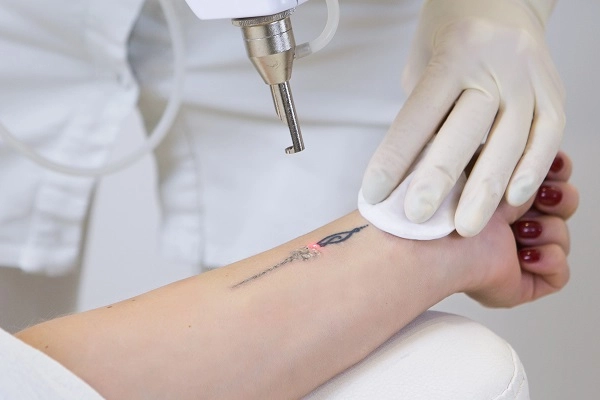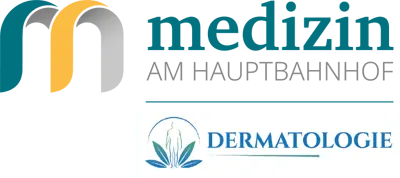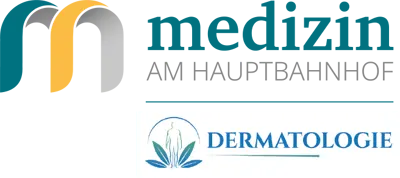 TATTOO REMOVAL:
TATTOO REMOVAL:
TATTOOS ARE A WAY TO SHOW YOUR INDIVIDUALITY, TO KEEP MEMORIES AWAKE OR TO PROFESS YOUR COLOR. SOMETIMES FACTS IN LIFE CHANGE OR YOU JUST DON'T LIKE A TATTOO ANYMORE AND YOU WANT TO CHANGE THE TATTOO OR MAKE ROOM FOR A NEW TATTOO. TATTOO REMOVAL WITH THE LATEST LASER TECHNOLOGY, THE PICO-LASER, CAN REMEDY HERE. HERE YOU CAN FIND OUT HOW TATTOO REMOVAL WORKS AND WHAT YOU HAVE TO CONSIDER.
Photo: © stanislav_uvarov – stock.adobe.com
-
How does the laser treatment work?
-
Which laser systems are there and what are the differences?
-
Does laser treatment cause pain?
-
How much will it cost to remove my permanent make-up or tattoo?
-
How many treatments are necessary? How long does the removal take?
-
What side effects can occur?
-
How do I have to care for my skin after the treatment?
-
Do you also do allergy tests on tattoo inks?
-
I got a new tattoo and I think I'm reacting to the tattoo color, what can I do?
-
I am planning a new tattoo but some moles are in the way, can I just tattoo over it?
-
I have now informed myself sufficiently and decided to have my tattoo removed. How do I proceed now?
How does the laser treatment work?
Laser removal is based on the fact that the laser emits extremely short but powerful light pulses. These light pulses have a specific wavelength that is matched to the color pigments of the tattoo. The color pigments absorb this energy and heat up so much that they are broken up into small particles. Only the pigments heat up, but not the surrounding skin. The small fragments are absorbed by the scavenger cells of the immune system and transported via the lymphatic system to the lymph nodes and excreted. In the following weeks you can see the color fading. With each additional treatment, the particles are further broken down and broken down.
Which laser systems are there and what are the differences?
There are several types of laser systems used for tattoo removal. When laser technology first came into use decades ago, it started with Q-Switch and ruby lasers. In the meantime, nano and even more modern pico lasers have arrived.
In our practice at Vienna Central Station we have a pico laser that can also be converted to a nano laser. Depending on the type of tattoo, the optimal parameters can be selected and a wide range of tattoo colors can be removed.
- Wavelength of 1064 nm: Effective for black, dark blue and dark brown tattoo inks
- Wavelength of 694 nm: Effective for blue, black, brown, green and purple tattoo inks
- Wavelength of 532 nm: Effective for red, orange, yellow, brown and purple tattoo inks
In addition to the wavelength, the pulse duration also plays a role. There are two main groups of lasers:
- Nanosecond laser with a pulse duration in the nanosecond range
- Picosecond lasers with wavelengths in the picosecond range.
A picosecond (1 ps = 10-12 s) is one trillionth part of a second and one thousandth of a nanosecond (1 ns = 10-9 s). Special technology and a lot of energy are required for these short impulses. However, this extra effort leads to less pain and side effects through targeted treatment.
When laser radiation is emitted in picosecond pulses, the laser light is absorbed by the color pigments and heated to over 900°C. The special innovation of the Discovery PICO laser available in our practice is its high peak power and ultra-short pulses. This leads to better treatment results and improved effectiveness in tattoo removal.
The choice of the appropriate laser system depends on the type and color of the tattoo and the skin type of the patient. As experienced dermatologists and laser therapists, we can determine the best method for each individual case here in our high-quality and diversely equipped practice at Vienna Central Station.
Does laser treatment cause pain?
Yes a little. Although the laser treatment is associated with slight pain, this is tolerable for most patients. The feeling of bursting open the color pigments can be compared to short splashes of hot fat or a hair pluck. If you are very sensitive to pain, you can apply a light numbing cream before the laser. Normally, however, the treatment is possible without any local anesthetic. Good cooling after the treatment quickly eliminates any irritation and swelling of the skin. You are immediately ready to participate in daily activities again and do not have to expect any downtime. A major advantage of the Quanta Discovery Pico compared to lasers in the nanosecond range is that the treatment is significantly less painful, gentler and has fewer side effects due to the short pulse duration.
How much will it cost to remove my tattoo?
The costs depend very much on the tattooed area, color variety, age of the tattoo and the depth of the pigment. How many sessions are required for complete or satisfactory removal then determines the total price. In the consultation, our dermatologists will draw up an individual treatment and cost plan with you. An approximate overview of the prices can be found here: Prices
up to 9 cm² or test zone: 100 EUR
10-25 cm²: 100-160 EUR
26-100 cm²: 160 - 290 EUR
101-250 cm²: 290 EUR - 350 EUR
400 cm²: 400 EUR
How many treatments are necessary? How long does the removal take?
How many treatments are needed to remove your tattoo depends on your individual constellation. These include the depth of the tattoo, its age, the quality and professionalism of the tattoo, the color composition and density, and the colors used. In addition, body part and skin condition as well as care during the after-treatment play an important role in the question of how many sessions are required.
Laser treatment itself does not take very long. Usually 6-14 treatments are recommended for the complete removal of a tattoo. For a cover-up, only a few treatments are usually sufficient to prepare the motif in such a way that the tattoo artist can start with the cover-up. Usually only between 3-6 treatments are needed for a complete removal of permanent make-up.
The interval between treatments should be at least 6-8 weeks, because that's how long it takes for the immune system to remove the destroyed paint particles. The intervals between the treatments can also become longer towards the end, since the immune system is still removing color even after months and the tattoo fades more and more.
In order to give the skin enough time to regenerate, you should wait at least 4-6 months after the last laser treatment before getting a new tattoo.
What side effects can occur?
Tension, redness, swelling. Before the treatment, you should feel well prepared and fully informed. This also includes the realistic assessment of any side effects that may occur. Common and common side effects of laser treatment are tightness, redness, and slight swelling and scabs. This skin irritation can last for a few days.
In rare cases, scarring can occur. Inflammations and short-term lymphatic discharge are also rare.
How do I have to care for my skin after the treatment?
Cooling and cream. Careful care and aftercare is crucial for successful and scar-free tattoo removal. The treated area must be cooled immediately after the treatment. It should be cleaned daily and then treated with a thin layer of anti-inflammatory cream twice a day.
The treated area should be kept as dry as possible and supplied with fresh air. If there is a feeling of tightness, apply a wound healing cream. However, thick ointments (e.g. Vaseline) are not suitable for this, your skin should be able to breathe! It is important not to scrape off any crusts that form, they are part of the normal healing process and premature removal increases the otherwise low risk of scars.
It is extremely important that you do not expose the treated areas to the sun. Sunscreen with a sun protection factor of 50+ must always be worn outdoors. However, it is even better to avoid the sun completely in the first few days after the treatment, as this can lead to unsightly discoloration of the skin. This discoloration often resolves on its own, but prevention is definitely a better option. We would be happy to advise you on optimal sun protection.
Do you also do allergy tests on tattoo inks?
Are you planning a tattoo and want to know if you are allergic to the color? Unfortunately, a prophetic test in advance does not allow any reliable statement about an allergy or the development of an allergy. Such a test can even lead to the development of an allergy.
Since January 2022 there has been a new regulation in the EU that regulates the use of colors for tattoos and permanent make-up. Further tightening is expected in 2023. Colors that are potentially carcinogenic are banned by REACH Regulation (EU) 2020/2081. Some blue and green color pigments are affected.
I got a new tattoo and I think I'm reacting to the tattoo color, what can I do?
Tattoo pigments are generally well tolerated, but still represent foreign bodies. Foreign bodies can trigger allergic reactions. If you suspect an infection or side effect, we encourage you to seek help. As dermatologists in Vienna, we specialize in tattoo treatments and side effects and are happy to help.
I am planning a new tattoo but some moles are in the way, can I just tattoo over it?
No Please not! Serious tattoo artists know that places where birthmarks or moles are should be left out with tattoos. If a mole has been tattooed, it is difficult for us dermatologists to check the mole and a melanoma can thus possibly remain undetected.
Sunscreen is always important, especially on tattooed areas. Due to the dark color, more sun and energy is absorbed, which can lead to skin damage more quickly. We would be happy to advise you on suitable care and protection for your skin and tattoos.
I have now informed myself sufficiently and decided to have my tattoo removed. How do I proceed now?
You arrange a tattoo removal consultation appointment with one of our doctors for a preliminary discussion. A test treatment is usually carried out right away. We take a close look at the site and check whether there are any contraindications that speak against tattoo removal. In addition to a test treatment, you will also receive your treatment plan for the removal. The cost of the consultation is 60 euros. There is an additional fee of 100 euros for the test treatment.



